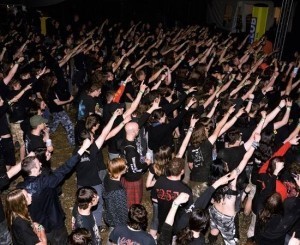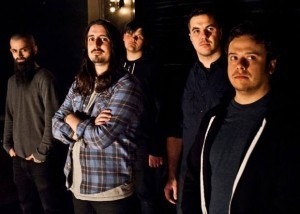
What’s more frustrating has been communicating with readers from varying cultural backgrounds who have expressed fear about attending shows in their cities, afraid that while they want to support their favorite metal, hardcore, or punk band, there might be a chance they’ll get their ass beat in doing so. Hindering people from actively participating in the heavy music scenes on the basis of their gender, ethnicity, or sexual orientation is not only morally wrong — it’s simply a crappy financial strategy. In order to keep the underground scene alive and thriving, more bodies are needed to attend shows, purchase music, buy merchandise, and spread the word to their immediate circles and online. So why is there still resistance to the growing diversity of heavy music fans?
The underground metal, hardcore, and punk scenes have always included women and people of various ethno-cultures and sexual preferences. In the late 1970s, UK metal band Girlschool and US punks The Runaways gained international prominence. The 1980s gave us the DC hardcore pioneers Bad Brains, while Doro Pesch became the vocalist for the German metal band Warlock, and guitarist Suzanne Thomas started the first all-black female metal band, PMS, in the early 1990s. These are just some of many: University of Central Missouri professor Amber Clifford-Napoleone documents queer metal musicians on her website, Queer F* Heavy Metal, and runs an extremely successful survey of queer metal fans.
Despite the gender diversity, attitudes are slow to change. In late January, MTV’s Ethan Fixell wrote an article entitled “Why Are There So Many Cute Girls and Metal & Hardcore Concerts Now?,” in which it was clear that a) he doesn’t go to many metal shows; and b) while women – umm, attractive women – were aplenty at the particular show he attended, they were only relevant to him in that he felt the need to provide quasi-predatory tips on how to pick them up.
You might argue that the article’s salaciousness was exaggerated to increase page views, but it’s indicative of deeper attitudes within the scene — there are plenty of other not-so-satirical articles written that depict women metal fans as sexually available or sexually aggressive, such as the 2011 Metalsucks post “Public Service Announcement: Girls Do Not Like Metal,” which suggests girls who claim to like metal do so only to attract attention, and the self-explanatory 2010 post from the same site, “Why Do Girls Eff Dudes in Bands?”
Both Fixell and Metalsucks contributor Sergeant D (whose tagline is “IF U DON’T LIKE THIS POST THAN FUCK OFF, I SERIASLY [sic] DON’T EVEN CARE”) position themselves as comedic writers, but the question remains: Why single out this demographic as the butt of your jokes, especially since there are very serious issues with sexism and misogyny in the real world?
“One of the most unfortunate aspects of Fixell’s article is that ‘cute girls’ (read: thin, white, cis, straight) are the only ‘girls’ at metal shows, completely discounting any other types of women that are in attendance. And yes, there are many other types of women at metal shows, not just those that are deemed acceptably sexy by MTV standards,” says Kristen Solee, who is the founder and editor of the sex-positive blog Slutist and teaches a class on fourth-wave feminism at The New School. She notes that the recent increase in online feminism has provided a strong alternative to the archaic notions contained in Fixell’s article. “This is part of a larger conversation that is really picking up to a level where it can no longer be ignored. And it’s not just about gender, but race and culture, too. Intersectional analysis of metal and the metal community is more and more the norm and articles like this are the exception.”
Solee is right that articles that position women as outsiders and others in the scene are the exception to the norm of what heavy music fans generally feel, but the next step is addressing not only exclusionary online articles, but also offline exclusionary behavior. I’m still hearing accounts of overt racial attacks at metal shows from men and women from various ethno-cultures. “Some people want to keep things to themselves in an odd way (by) keeping the underground scene marginalized, but I think that what I’ve been seeing lately [is] that it’s trending towards more diversity within the scenes,” says David Castillo, events director for Brooklyn venue Saint Vitus (mentioned in Fixell’s article as a place to pick up “cute girls,” prompting Caroline Harrison, the venue’s social media director, to pen a response). “It’s getting away from heavy music just being considered some white boy s**t.”
A first-generation Colombian American, Castillo — who is also the vocalist for both White Widows Pact and Primitive Weapons — adds that the cultural diversity he saw in the bands he loved and in New York’s Lower East Side hardcore scene served as an inspiration for him as a teenager. “[When] was I was growing up it was bands like Sepultura, Dino [Cazares] from Fear Factory, and Freddy [Cricien] from Madball. When I discovered them, it made me feel cool that my ethnicity and the music don’t have to conflict. And there are more examples for kids right now. As time goes on, and with the internet, you don’t necessarily have to be within a physical space to appreciate something. The way that you can socialize into something has changed a lot. It is a lot easier, and if they dig it, they dig it.”
The internet does provide easy access to a variety of underground heavy music, but for some going to a show is the only place and time they can congregate with like-minded folks. And such shows can still be hostile places — for instance, a show last fall at Acheron in the extremely multi-ethnic borough Brooklyn, where the diversity of the neighborhood and the patrons did not deter the venue from hosting an Oi! skinhead show, causing some audience members to leave. Apparently Acheron’s owners were unaware that the bands featured — which included Oxblood, Offensive Weapon, Stormwatch, The Wolverines, and Maddog Surrender — were Nazi skins, but on the other hand, the show was never pre-promoted on the venue’s social media sites, and you have to ask if it’s really possible that the bookers were entirely ignorant of the bands’ politics. C’mon, Stormwatch?
Daniel Gallant, a former neo-Nazi and a graduate student in at the University of Northern British Columbia (UNBC), is recognized as an expert on the white supremacist movement in Canada. A longtime metal fan who researches hate groups involved in the West Coast black metal scene, he says that complicity is a huge factor in alienating music fans: a venue or a booker does not have to hold overtly racist views to book self-identified racist bands.
He recounts a conversation he had with a white female black metal musician and author, who willingly performed at a reading event alongside a First Nations poet despite having also credited several white power bands in the acknowledgement section of one of her books. “I asked her [about that] and she indicated that she did not care about people’s politics. It seemed that although she may not agree, she was complicit within [encouraging] not just racism but also extremist violence. One of the lead singers [of the bands she thanked] was one of two Nazis arrested with a house full of guns and drugs and had [faced] a total of 50-plus criminal charges. In fact, I had previously recruited both guys into white power networks.”
I asked Castillo if he’s ever had an issue with unwittingly booking a band that could potentially alienate their regulars. “Vetting bands is a difficult process,” he explains. “It’s hard to gauge people’s attitudes are from the music and content – what is out there in the public eye. Sometimes it’s not the content that bothers people; it’s something that particular people have done or aligned themselves with. It’s not like you can pinpoint it as some form of hate speech. It’s a myriad of different things and it’s difficult to say unless it comes from the person’s mouth. I’m not personally sitting around listening to NSBM [National Socialist black metal] – I’m a Colombian dude! It has nothing to do with me!”
The best thing about trying to increase the diversity within heavy music scenes is that there are a whole lot of people already doing it who can lead by example. Perhaps the white dudes who tried to dismiss my book are partly right: Because of the relative ease of accessing a myriad of different styles of music, perhaps music really doesn’t have a color, as it is created to provide enjoyment to everyone. It’s up to us fans to not only respect the culture that gives us so much joy, but also to remind ourselves the next time we feel the need to exclude people from a musical culture that we are not only hurting the bands we love — more importantly, we’re hurting ourselves.
